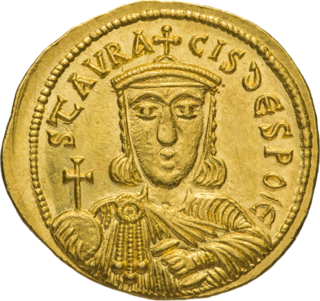
Nikephoros I or Nicephorus I was Byzantine emperor from 802 to 811. Having served Empress Irene as genikos logothetēs, he subsequently ousted her from power and took the throne himself. In reference to his career before becoming Emperor, he is sometimes surnamed "the Logothete" and "Genikos" or "Genicus". Nikephoros pursued wars against the Arabs and Bulgarians, with mixed results; while invading Bulgaria he was defeated and killed at the Battle of Pliska.

Staurakios or Stauracius was Byzantine emperor from 26 July to 2 October 811. He was born in the early 790s, probably between 791 and 793, to Nikephoros I and an unknown woman. Nikephoros seized the throne of the Byzantine Empire from Empress Irene in 802, and elevated Staurakios to co-emperor on 25 December 803. On 20 December 807, a bride show was held by Nikephoros to select a wife for Staurakios, which resulted in his marriage to Theophano of Athens, a kinswoman of Irene. Little else is known of him until he came to take the throne upon the death of Nikephroros.
Jacob of Edessa was Bishop of Edessa and prominent Syriac/Assyrian Christian writer in Classical Syriac language, also known as one of earliest Syriac grammarians. In various works, he treated theological, liturgical, canonical, philosophical and historical subjects, and contributed significantly to scholarly and literary development of Syriac Christianity. He is considered to be one of the most important scholars of the Christian-Aramean tradition.
Tārīkh Ibn Wāḍiḥ or popularly Tārīkh al-Yaʿqūbī is a well-known classical Islamic history book, written by al-Yaʿqūbī.
John III of the Sedre was the Patriarch of Antioch and head of the Syriac Orthodox Church from 631 until his death in 648. He is commemorated as a saint by the Syriac Orthodox Church, and his feast day is 14 December.
Athanasius II Baldoyo, also known as Athanasius of Balad, and Athanasius of Nisibis, was the Patriarch of Antioch and head of the Syriac Orthodox Church from 684 until his death in 687.

Michael the Syrian ,(Classical Syriac: ܡܺܝܟ݂ܳܐܝܶܠ ܣܽܘܪܝܳܝܳܐ, romanized: Mīkhoʾēl Sūryoyo), died 1199 AD, also known as Michael the Great or Michael Syrus or Michael the Elder, to distinguish him from his nephew, was a patriarch of the Syriac Orthodox Church from 1166 to 1199. He is best known today as the author of the largest medieval Chronicle, which he wrote in the Syriac language. Some other works and fragments written by him have also survived.
Quriaqos of Tagrit was the Patriarch of Antioch, and head of the Syriac Orthodox Church, from 793 until his death in 817. He is commemorated as a saint by the Syriac Orthodox Church in the Martyrology of Rabban Sliba, and his feast day is 13 or 16 August.
Elias I of Antioch was the Patriarch of Antioch and head of the Syriac Orthodox Church from 709 until his death in 723. He is commemorated as a saint by the Syriac Orthodox Church in the Martyrology of Rabban Sliba, and his feast day is 3 November.
Julian I was the Patriarch of Antioch and head of the Syriac Orthodox Church from 591 until his death in 594/595. He is commemorated as a saint by the Syriac Orthodox Church.
Iwannis I was the Patriarch of Antioch and head of the Syriac Orthodox Church from 739/740 until his death in 754/755.
Dionysius II was the Patriarch of Antioch and head of the Syriac Orthodox Church from 896/897 until his death in 908/909.
Julian II, also known as Julian the Roman or Julian the Soldier, was the Patriarch of Antioch and head of the Syriac Orthodox Church from 687 until his death in 708.
Qenneshre was a large West Syriac monastery between the 6th and 13th centuries. It was a centre for the study of ancient Greek literature and the Greek Fathers, and through its Syriac translations it transmitted Greek works to the Islamic world. It was "the most important intellectual centre of the Syriac Orthodox ... from the 6th to the early 9th century", when it was sacked and went into decline.
The Chronicle of 846 is a fragmentary universal chronicle written in Syriac by an anonymous author sometime between 846 and 873. Its focus for the later centuries, where it is most valuable, is ecclesiastical history. It is written from a Syriac Orthodox perspective.
The Chronicle of 819, also called the Chronicle of Qarṭmin, is a chronological table of important events and people from the birth of Jesus down to the year AD 819 written in Syriac by an anonymous Miaphysite monk from the monastery of Qarṭmin. It contains lists of the Abbasid caliphs for 785–813 and the Syriac Orthodox patriarchs for 788–819.
Athanasius III was the Patriarch of Antioch and head of the Syriac Orthodox Church from 724 until his death in 739/740.
Isaac I was the Patriarch of Antioch and head of the Syriac Orthodox Church from 755 until his death in 756. Isaac's uncanonical elevation to the patriarchal office has led him to be regarded as an illegitimate patriarch.
Theodoret was the Melkite patriarch of Antioch in the late 8th century and possibly into the 9th, during the reign of the Abbasid caliph Harun al-Rashid. The exact dates of his patriarchate are the subject of disagreement. Date ranges of c. 787–c. 799, 795–812 and c. 794–811 have been offered.